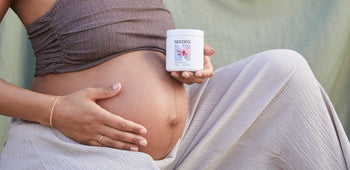We all know that periods can come with cramps and plenty of other potential symptoms. But have you ever experienced cramps but no period?
We’re often quick to blame our hormones or cycle for cramps, but the truth is, there are many other causes for cramping but no period. Let’s learn a bit more about each of these potential causes.
Possible Causes of Cramps Without Having a Period
There are many possible causes of cramps that are unrelated to having your period. Here are 11 possible causes:
Constipation
Constipation refers to infrequent bowel movements. A person is typically considered constipated if they are having fewer than three bowel movements per week.
While it may seem like an unrelated system, digestive bloating and cramping can be hard to differentiate from menstrual cramping. Tracking the frequency of your bowel movements can help determine if constipation may be the cause of your cramps.
If so, check out these eight remedies for constipation. They happen to be safe for pregnancy and postpartum, but are effective at any stage!
Digestive issues
If your cramps are paired with digestive symptoms, there might be an underlying digestive or gut condition at play. Reach out to a trusted practitioner if you’re experiencing any of the following for longer than two weeks.
- Diarrhea
- Alternating between diarrhea and constipation
- Mucus in the stool
- Bloating
- Excessive gas
- Discomfort in the upper abdomen
- Feeling uncomfortably full or nauseated after eating
- Loss of appetite
- Rectal bleeding
- Skin rashes
Ovulation
Ovulation pain, also called mittelschmerz, can cause mild cramping. It is estimated that mittelschmerz may affect over 40% of women of reproductive age. It occurs almost every month in these women.
Learn more about other signs of ovulation here.
Early Pregnancy
Cramping can also be an early sign of pregnancy. Light cramping typically happens during the first trimester. If you have cramps along with a missed period, you may want to consider taking a pregnancy test.
If you know you are pregnant and are experiencing more serious cramping along with pelvic pain, lower back pain, dizziness, or bleeding, reach out to your OB or midwife immediately.
Pelvic Inflammatory Disease
Pelvic inflammatory disease (PID), a serious infection of the uterus, fallopian tubes, or ovaries. PID is typically caused by bacteria from untreated sexually transmitted infections. However, it can also develop when bacteria that normally lives in the vagina gets into your reproductive organs during childbirth, miscarriage, surgery, or IUD insertion.
PID is not common, but it is very serious and requires immediate treatment. In addition to cramping, other symptoms of PID include abnormal discharge, chills, fever, nausea, vomiting, pain during sex, a burning sensation while urinating, or irregular periods.
Endometriosis
Endometriosis is a condition in which endometrial tissue grows outside the uterus. It affects between 5% and 15% of women and adolescents of reproductive age.
Endometriosis typically makes menstrual cramps even more painful, and it can also cause pain and cramping when you don’t have your period. If you’re experiencing painful periods or any of these other symptoms, reach out to your OB or midwife for support.
Ovarian cysts
Ovarian cysts are small, fluid-filled sacs that form in or on the ovaries. Many ovarian cysts don’t cause any symptoms at all and resolve on their own, but some ovarian cysts grow larger and cause pressure or pain in the lower abdomen.
Fibroids
Uterine fibroids are noncancerous tumors that form in or on the wall of the uterus. Uterine fibroids may cause no symptoms at all, but they can also cause discomfort and cramping. They can also cause pain, heavy or irregular vaginal bleeding, frequent urination, pain during sex, and constipation.
It is estimated that between 40% and 80% of people with a uterus will develop fibroids at some point. They occur most often in women between 30 and 50 years old.
UTI
A urinary tract infection (UTI) can cause pressure or cramping in the groin or lower abdomen. The discomfort caused by a UTI can feel similar to menstrual cramps. A UTI also typically comes with painful or frequent urination.
Hormonal Birth Control
Some women choose to take hormonal birth control in an attempt to help manage cramps and other side effects. However, relief from symptoms isn’t always the case, and birth control can come with other unwanted side effects. Most birth control pills contain synthetic forms of the hormones estrogen and progesterone, and for some women, the added hormones can cause cramping.
Food intolerance or sensitivity
Food intolerances or sensitivity can cause cramping. Cramps typically present alongside other symptoms, including gas, bloating, diarrhea, nausea, or skin rashes.
For example, lactose intolerance is when the body is unable to digest lactose, the natural sugar found in milk and dairy products.. Symptoms for lactose intolerance typically appear within two hours of consuming dairy products, but other foods can take up to 24 hours. Try keeping a food journal to see if dairy (or any other food) might be the cause of your cramping.
How to find relief from cramping
Cramps can be uncomfortable and disruptive. Here are a few things you can do at home to ease some of the discomfort, whether from menstrual cramps or other cramps:
- Take a warm bath
- Use a heating pad or hot water bottle on the abdomen
- Drink ginger tea - one study found that 250 mg of ginger powder four times a day for three days helped with menstrual pain relief. In fact, it concluded that ginger was as effective as ibuprofen. Of course, always check with your practitioner before introducing any new supplementation, especially if you suspect another health condition or take other medication.
- Exercise - Research has suggested that exercise is effective at reducing menstrual pain. Even moderate activity like walking can be beneficial.
It’s important to note that while these remedies can provide some relief, they aren’t meant to replace treatment, especially if there is a serious underlying condition.
When to see a doctor
If you are experiencing frequent cramps that happen away from your period, reach out to a healthcare practitioner. It is important to get help in identifying the root cause of your cramps so that it can be properly addressed.
Anyone experiencing frequent cramps outside of their period should speak to a trusted healthcare practitioner for a proper diagnosis.













